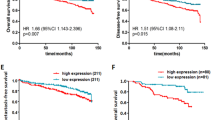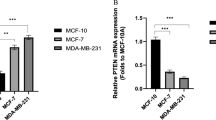Abstract
Emerging evidence suggests the potential involvement of altered regulation of miRNAs in the pathogenesis of cancers, and these miRNAs are thought to be functional as tumor suppressors or oncogenes. Using miRNA arrays, we identified an miRNA differentially expressed between the MDA-MB-231 cell line and its highly metastatic variant. A bioinformatics search revealed a potential target site for miR-193b within the 3′UTR of uPA. Ectopic expression of miR-193b repressed the expression of sensor constructs harboring the 3′UTR of uPA in breast cancer cell lines. Anti-miR-193b treatment led to an increase of uPA protein and increased cell invasion in MDA-MB-231 cells. In contrast, overexpression of miR-193b significantly reduced uPA protein amounts and inhibited cell invasion in MDA-MB-231 and MDA-MB-435 cells. In an immunodeficient mouse model, miR-193b significantly inhibited the growth and dissemination of xenograft tumors. Immunohistochemical staining and real-time PCR assays showed that miR-193b was a negative regulator of the uPA gene in primary breast tumors. Our research reveals that miR-193b is closely associated with clinical metastasis and identifies miR-193b potentially targets uPA transcripts. Perturbation of the miRNA–mRNA pairing may have important roles in the initiation and development of breast cancer.
This is a preview of subscription content, access via your institution
Access options
Subscribe to this journal
Receive 50 print issues and online access
$259.00 per year
only $5.18 per issue
Buy this article
- Purchase on Springer Link
- Instant access to full article PDF
Prices may be subject to local taxes which are calculated during checkout








Similar content being viewed by others
Abbreviations
- ELISA:
-
enzyme-linked immunosorbent assay
- miRNA:
-
microRNA
- SCID mice:
-
severe combined immune deficiency mice
- uPA:
-
urokinase plasminogen activator
- 3′-UTR:
-
3′-untranslated region
References
Achbarou A, Kaiser S, Tremblay G, Ste-Marie LG, Brodt P, Goltzman D et al. (1994). Urokinase overproduction results in increased skeletal metastasis by prostate cancer cells in vivo. Cancer Res 54: 2372–2377.
Ambros V . (2004). The functions of animal microRNAs. Nature 431: 350–355.
Asangani IA, Rasheed SA, Nikolova DA, Leupold JH, Colburn NH, Post S et al. (2007). MicroRNA-21 (miR-21) post-transcriptionally downregulates tumor suppressor Pdcd4 and stimulates invasion, intravasation and metastasis in colorectal cancer. Oncogene 27: 2128–2136.
Bartel DP . (2004). MicroRNAs: genomics, biogenesis, mechanism, and function. Cell 116: 281–297.
Biermann JC, Holzscheiter L, Kotzsch M, Luther T, Kiechle-Bahat M, Sweep FC et al. (2008). Quantitative RT-PCR assays for the determination of urokinase-type plasminogen activator and plasminogen activator inhibitor type 1 mRNA in primary tumor tissue of breast cancer patients: comparison to antigen quantification by ELISA. Int J Mol Med 21: 251–259.
Blasi F . (1993). Urokinase and urokinase receptor: a paracrine/autocrine system regulating cell migration and invasiveness. BioEssays 15: 105–111.
Busso N, Masur SK, Lazega D, Waxman S, Ossowski L . (1994). Induction of cell migration by pro-urokinase binding to its receptor: possible mechanism for signal transduction in human epithelial cells. J Cell Biol 126: 259–270.
Calin GA, Liu CG, Sevignani C, Ferracin M, Felli N, Dumitru CD et al. (2004a). MicroRNA profiling reveals distinct signatures in B cell chronic lymphocytic leukemias. Proc Natl Acad Sci USA 101: 11755–17760.
Calin GA, Sevignani C, Dumitru CD, Hyslop T, Noch E, Yendamuri S et al. (2004b). Human microRNA genes are frequently located at fragile sites andgenomic regions involved in cancers. Proc Natl Acad Sci USA 101: 2999–3004.
Castelló R, Landete JM, España F, Vázquez C, Fuster C, Almenar SM et al. (2007). Expression of plasminogen activator inhibitors type 1 and type 3 and urokinase plasminogen activator protein and mRNA in breast cancer. Thromb Res 120: 753–762.
Chan JA, Krichevsky AM, Kosik KS . (2005). MicroRNA-21 is an antiapoptotic factor in human glioblastoma cells. Cancer Res 65: 6029–6033.
Chapman HA . (1997). Plasminogen activators, integrins, and the coordinated regulation of cell adhesion and migration. Curr Opin Cell Biol 9: 714–724.
Cimmino A, Calin GA, Fabbri M, Iorio MV, Ferracin M, Shimizu M et al. (2005). miR-15 and miR-16 induce apoptosis by targeting BCL2. Proc Natl Acad Sci USA 102: 13944–13949.
Foekens JA, Peters HA, Look MP, Portengen H, Schmitt M, Kramer MD et al. (2000). The urokinase system of plasminogen activation and prognosis in 2780 breast cancer patients. Cancer Res 60: 636–643.
Frandsen TL, Holst-Hansen C, Nielsen BS, Christensen IJ, Nyengaard JR, Carmeliet P et al. (2001). Direct evidence of the importance of stromal urokinase plasminogen activator (uPA) in the growth of an experimental human breast cancer using a combined uPA gene-disrupted and immunodeficient xenograft model. Cancer Res 61: 532–537.
Guo Y, Chen Z, Zhang L, Zhou F, Shi S, Feng X et al. (2008). Distinctive microRNA profiles relating to patient survival in esophageal squamous cell carcinoma. Cancer Res 68: 26–33.
Gupta GP, Massagué J . (2006). Cancer metastasis: building a framework. Cell 127: 679–695.
Holst-Hansen C, Johannessen B, Høyer-Hansen G, Rømer J, Ellis V, Brünner N . (1996). Urokinase-type plasminogen activation in three human breast cancer cell lines correlates with their in vitro invasiveness. Clin Exp Metastasis 14: 297–307.
Huang Q, Gumireddy K, Schrier M, le Sage C, Nagel R, Nair S et al. (2008). The microRNAs miR-373 and miR-520c promote tumor invasion and metastasis. Nat Cell Biol 10: 202–210.
Iorio MV, Ferracin M, Liu CG, Veronese A, Spizzo R, Sabbioni S et al. (2005). MicroRNA gene expression deregulation in human breast cancer. Cancer Res 65: 7065–7070.
John B, Enright AJ, Aravin A, Tuschl T, Sander C . (2004). Human microRNA targets. PLoS Biol 11: 1862–1879.
Johnsen M, Lund LR, Rømer J, Almholt K, Danø K . (1998). Cancer invasion and tissue remodeling: common themes in proteolytic matrix degradation. Curr Opin Cell Biol 10: 667–671.
Krek A, Grün D, Poy MN, Wolf R, Rosenberg L, Epstein EJ et al. (2005). Combinatorial microRNA target predictions. Nat Genet 37: 495–500.
Lewis BP, Burge CB, Bartel DP . (2005). Conserved seed pairing, often flanked by adenosines, indicates that thousands of human gene are microRNA targets. Cell 120: 15–20.
Lewis BP, Shih IH, Jones-Rhoades MW, Bartel DP, Burge CB . (2003). Prediction of mammalian microRNA targets. Cell 115: 787–798.
Li DQ, Wang L, Fei F, Hou YF, Luo JM, Chen W et al. (2006). Identification of breast cancer metastasis-associated proteins in an isogenic tumor metastasis model using two-dimensional gel electrophoresis and liquid chromatography-ion trap-mass spectrometry. Proteomics 6: 3352–3368.
Ma L, Teruya-Feldstein J, Weinberg RA . (2007). Tumor invasion and metastasis initiated by microRNA-10b in breast cancer. Nature 449: 682–688.
McSherry EA, Donatello S, Hopkins AM, McDonnell S . (2007). Molecular basis of invasion in breast cancer. Cell Mol Life Sci 64: 3201–3218.
Murchison EP, Hannon GJ . (2004). miRNAs on the move: miRNA biogenesis and the RNAi machinery. Curr Opin Cell Biol 16: 223–229.
Nanbu R, Menoud PA, Nagamine Y . (1994). Multiple instability-regulating sites in the 3′ untranslated region of the urokinase-type plasminogen activator mRNA. Mol Cell Biol 14: 4920–4928.
Pakneshan P, Szyf M, Farias-Eisner R, Rabbani SA . (2004a). Reversal of the hypomethylation status of urokinase (uPA) promoter blocks breast cancer growth and metastasis. J Biol Chem 279: 31735–31744.
Pakneshan P, Têtu B, Rabbani SA . (2004b). Demethylation of urokinase promoter as a prognostic marker in patients with breast carcinoma. Clin Cancer Res 10: 3035–3041.
Pulukuri SM, Rao JS . (2007). Small interfering RNA directed reversal of urokinase plasminogen activator demethylation inhibits prostate tumor growth and metastasis. Cancer Res 67: 6637–6646.
Rabbani SA, Mazar AP . (2007). Evaluating distant metastases in breast cancer: from biology to outcomes. Cancer Metastasis Rev 26: 663–674.
Rabbani SA, Xing RH . (1998). Role of urokinase (uPA) and its receptor (uPAR) in invasion and metastasis of hormone-dependent malignancies. Int J Oncol 12: 911–920.
Sidenius N, Blasi F . (2003). The urokinase plasminogen activator system in cancer: recent advances and implication for prognosis and therapy. Cancer Metastasis Rev 22: 205–222.
Sliva D, Rizzo MT, English D . (2002). Phosphatidylinositol 3-kinase and NF-kappaB regulate motility of invasive MDA-MB-231 human breast cancer cells by the secretion of urokinase-type plasminogen activator. J Biol Chem 277: 3150–3157.
Tavazoie SF, Alarcón C, Oskarsson T, Padua D, Wang Q, Bos PD et al. (2008). Endogenous human microRNAs that suppress breast cancer metastasis. Nature 451: 147–152.
Tetu B, Brisson J, Lapointe H, Bernard P . (1998). Prognostic significance of stromelysin 3, gelatinase A and urokinase expression in breast cancer. Hum Pathol 29: 979–985.
Têtu B, Brisson J, Wang CS, Lapointe H, Beaudry G, Blanchette C . (2001). Expression of cathepsin D, stromelysin-3 and urokinase by reactive stromal cells on breast carcinoma prognosis. Cancer 92: 2957–2964.
Volinia S, Calin GA, Liu CG, Ambs S, Cimmino A, Petrocca F et al. (2006). A microRNA expression signature of human solid tumors defines cancer gene targets. Proc Natl Acad Sci USA 103: 2257–2261.
Yang H, Kong W, He L, Zhao JJ, O’Donnell JD, Wang J et al. (2008). MicroRNA expression profiling in human ovarian cancer: miR-214 induces cell survival and cisplatin resistance by targeting PTEN. Cancer Res 68: 425–433.
Acknowledgements
This research was supported in part by grants from the National Basic Research Program of China (2006CB910501), National Natural Science Foundation of China (30371580, 30572109) and Shanghai Science and Technology Committee (03J14019, 06DJ14004, 06DZ19504).
Author information
Authors and Affiliations
Corresponding author
Additional information
Supplementary Information accompanies the paper on the Oncogene website (http://www.nature.com/onc)
Rights and permissions
About this article
Cite this article
Li, XF., Yan, PJ. & Shao, ZM. Downregulation of miR-193b contributes to enhance urokinase-type plasminogen activator (uPA) expression and tumor progression and invasion in human breast cancer. Oncogene 28, 3937–3948 (2009). https://doi.org/10.1038/onc.2009.245
Received:
Revised:
Accepted:
Published:
Issue Date:
DOI: https://doi.org/10.1038/onc.2009.245
Keywords
This article is cited by
-
The Potential of Circulating miR-193b, miR-146b-3p and miR-483-3p as Noninvasive Biomarkers in Cutaneous Melanoma Patients
Molecular Biotechnology (2023)
-
Coordinated regulation of WNT/β-catenin, c-Met, and integrin signalling pathways by miR-193b controls triple negative breast cancer metastatic traits
BMC Cancer (2021)
-
Additive effect of metastamiR-193b and breast cancer metastasis suppressor 1 as an anti-metastatic strategy
Breast Cancer (2019)
-
TIPE2 acts as a biomarker for tumor aggressiveness and suppresses cell invasiveness in papillary thyroid cancer (PTC)
Cell & Bioscience (2018)
-
Identifying the miRNA signature associated with survival time in patients with lung adenocarcinoma using miRNA expression profiles
Scientific Reports (2017)



